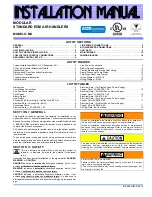
blaubergventilatoren.de
CiViC eC d(1)B(e; e2)
21
TROUBLE
POSSIBLE REASONS
TROUBLESHOOTING
The fan(s) do(es) not get
started during activation of
the unit.
No power supply.
Make sure the power supply line is connected
correct. Otherwise troubleshoot a connection error.
Motor or impeller clogging.
Turn the unit off. Troubleshoot the fan clogging.
Clean the blades.
Restart the unit.
System failure. The list of the system alarms is
stated in the user's manual (control panel).
Go to the active alarm page, detect a system failure
and troubleshoot it.
Contact the unit Seller if your efforts to troubleshoot
the alarm independently fail.
Automatic circuit breaker
tripping after the unit start-
up.
Over-current as a result of short circuit in the
electric circuit.
Turn the unit off. Contact the unit Seller.
Low air flow.
Low set fan speed.
Set higher speed.
Clogged filters, fans or heat exchanger.
Clean or replace the filters. Clean the fans and the
heat exchanger.
Clogged or damaged air ducts, diffusers,
louver shutters, grilles or other ventilation
system components.
Clean or replace the air ducts, diffusers, louver
shutters, grilles or other ventilation system
components.
Low supply air temperature.
Clogged extract filter.
Clean or replace the extract filter.
Contaminated heat exchanger.
Clean the heat exchanger.
Noise, vibration.
Clogged impeller or impellers.
Clean the impeller or impellers.
Loose screw connection in the fan or in the
casing.
Tighten the screws of the fans or the casing against
stop.
No anti-vibration connectors on the
connection spigots.
Install the rubber anti-vibration connectors.
STORAGE AND TRANSPORTATION REGULATIONS
• Store the unit in the manufacturer’s original packaging box in a dry closed ventilated premise with temperature range +5 ˚C...+40 ˚C
and relative humidity up to 70 %.
• Storage environment must not contain aggressive vapors and chemical mixtures provoking corrosion, insulation, and sealing
deformation.
• Use suitable hoist machinery for handling and storage operations to prevent possible damage to the unit.
• Follow the handling requirements applicable for the particular type of cargo.
• The unit can be carried in the original packaging by any mode of transport provided proper protection against precipitation and
mechanical damage. The unit must be transported only in the working position.
• Avoid sharp blows, scratches, or rough handling during loading and unloading.
• Prior to the initial power-up after transportation at low temperatures, allow the unit to warm up at operating temperature for at least
3-4 hours.
TROUBLESHOOTING


























